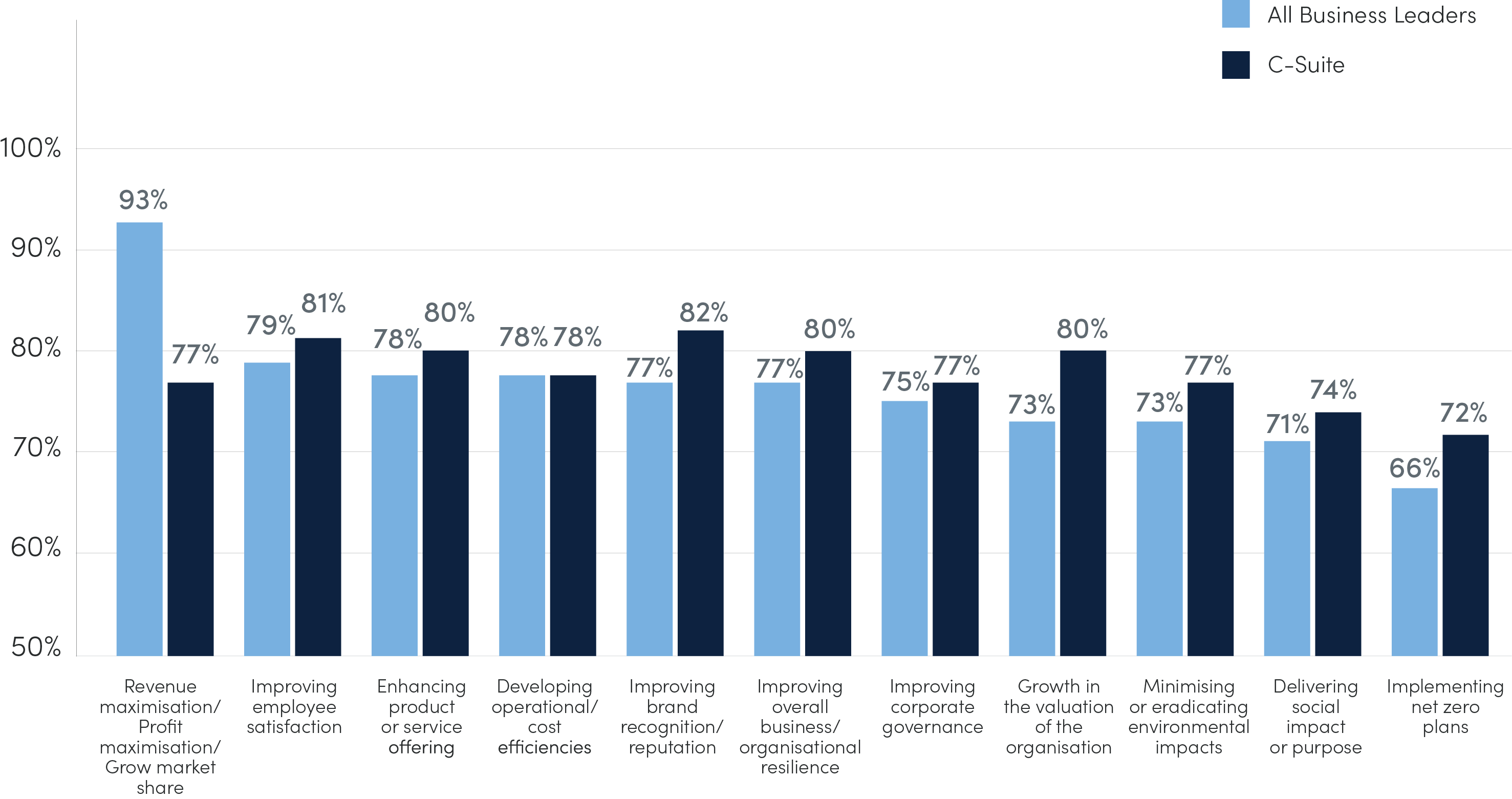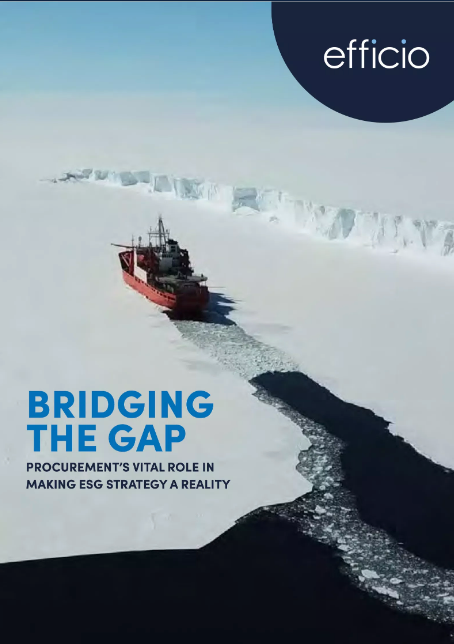Bridging the gap: Part 1
How does ESG stack up as a strategic priority?
A business’s strategic priority is generally to maximize revenue and profit, with employee satisfaction, product offering, efficiency, and brand being key supporting priorities to most organizations. Although further down this list, ESG factors are also clearly recognized as strategic by most respondents – and more so by the C-suite than other demographics. This is great news for sustainability and, in turn, sustainable procurement.
A further key observation is that, after revenue and profitability, there is long list of similarly high-importance business activities that 70% or more of responders recognize.
There is simply a lot to do in these uncertain times – and this comes with a very real risk that not everything will get done.
Q: HOW IMPORTANT ARE EACH OF THE FOLLOWING STRATEGIC PRIORITIES TO YOUR ORGANISATION OVER THE NEXT 2 YEARS?
(BASE: BUSINESS LEADERS) % reporting very important or extremely important

FIGURE 1:
Hard-nosed business objectives are undoubtedly the greatest focus among Business Leaders; however, a sizeable majority are paying attention to ESG priorities
Expert view

Paul Ekins OBE
Professor of Energy and Environment Policy, University College London
"BY ASSESSING AND SCREENING SUPPLIERS, PROCUREMENT CAN BE INSTRUMENTAL TO THE REDUCTION OF SCOPE 3 EMISSIONS.”
With decades of experience understanding the tensions between economic growth and environmental sustainability, Professor Ekins shares his insights on how climate change is likely to affect our lives in the coming years and which actions businesses, governments, and individuals can take to mitigate its impact.
Read the full interviewFollow the money
The corporate landscape is changing at a faster pace than ever before and, after more than two years of turmoil, organisations are reassessing all facets of their businesses. Core to this is investing in strategic projects that create long-term business value, secure business-resilience, and formally embed new ways of working.
Our research shows that almost half (49%) of corporates are investing in digital transformation programmes. Companies see adopting more agile IT infrastructure that builds enterprise-wide resilience geared to meet any future periods of uncertainty as a key success factor. Talent management remains as critical as ever.
Q. IN WHICH PROJECTS OR ACTIVITIES ARE YOU CURRENTLY INVESTING?

FIGURE 2:
While traditional business objectives still dominate the agenda, two of the top five strategic projects Business Leaders are investing in are ESG-focussed
Businesses need to demonstrate their commitment to sustainability through actions. There are some companies that have really pushed the boat out. Motorcar manufacturers like Volvo are starting to use coal- free green steel, which would have been unimaginable a few years ago due to the price of the innovative technologies it requires. But they were bold and reckoned that their customers would be willing to absorb that higher price in exchange for a ‘green’ car.

Lip service or real intent?
There is, however, much to infer from where an organisation spends its money. Whilst businesses are also planning to spend on Environmental Sustainability (47%) and Diversity, Equity, and Inclusion (35%), the relative disconnect with strategic priorities implies that organisations are either early in the journey, and so still need to gear up, or that the investment is a compliance measure, and so is more needs-focussed than strategic. It is likely both, in many cases.
It should therefore generally be viewed as a warning sign that we are still not acting on ESG issues fast enough, nor with the commitment to make real change.
One organisation leading the way with clear intent and a plan to match – and offering a blue-print for other organisations – is the UK’s National Health Service.
Expert view

Dr Nick Watts
Chief Sustainability Officer, NHS
"WE ARE DECARBONISING THE FIFTH LARGEST ORGANISATION IN THE WORLD.”
As the link between climate change and human health becomes increasingly obvious, Dr Nick Watts is focussed on driving the NHS's overarching goal to provide high-quality care for all – now and for future generations – through building up the resilience of the NHS, its supply chain, and the wider healthcare system. The NHS is the publicly funded healthcare system in the UK. It is one of the largest employers in the word, and is the biggest in Europe, with over 1.3 million staff.
Read the full interviewESG ambition and target setting
Target setting has been an enduring tool used by businesses to generate action and behaviour change within an organisation. As the boardroom agenda shifts to include ESG factors alongside more traditional measures of business success – such as revenue, profit, and market share – new commitments are being made to sustainability targets.
More than three quarters of businesses have set – or are in the process of setting – a target to reduce or eradicate waste material (76%), adapt to responsible resource consumption (76%), and improve social or community impacts (76%).
Q. HAS YOUR ORGANISATION SET TARGETS OR MADE COMMITMENTS RELATED TO ANY OF THE FOLLOWING?
(BUSINESS LEADERS)

FIGURE 3:
Organisations are most likely to have set or be setting environmental related targets; however, many are not very confident in meeting them
Concerningly, that leaves 26% of businesses that have not started on the journey of target setting for a significant issue like the eradication of greenhouse gas emissions.
According to research by CDP (a world-leading non-profit environmental disclosure platform), companies face up to US$120 billion in costs from environmental risks in their supply chains by 2026 2. Similarly, earlier this year, the Bank of England’s first climate stress test suggested that UK banks and insurers would end up taking on nearly £340bn-worth of climate-related losses by 2050 unless action was taken to curb rising temperatures and sea levels. 3
Target setting is a catalyst for action. Therefore, we can argue that not setting targets on these issues is riskier than target setting and then falling short of those targets. However, there should be genuine intent as setting a goal is, in many ways, the easy part. Businesses must first identify relevant metrics and indicators to measure and manage progress. Transparency will also form a key element to the successful governance of ESG target setting.
Significantly, expectations about the ability for a business to meet its own commitments are low. Of the 74% of businesses who have set or are in the process of setting a target for greenhouse gas emissions reduction or eradication, just 33% of their Business Leaders feel very confident in their organisation’s ability to meet the target.
Companies that do not transition to sustainable operations face increased risk, both operationally and reputationally – and yet ESG strategies and execution are not being aligned in many organisations. There are consequences of not meeting goals – particularly with an ever-increasing number of firms making their ESG commitments public in the form of annual sustainability-related reporting, signing public pledges, or through direct B2B or B2C marketing activity. Many Business Leaders are acutely aware of the reputational risks of making public commitments but, concerningly, one third (33%) do not identify that overpromising on sustainability-related goals is a major reputational risk for their organisation.
Emma Howard Boyd, Chair of the Environment Agency recently highlighted the risks of businesses failing to make credible plans and progress. This can lead to greenwashing and the danger is, she says, that people “won’t realise this deception until it is too late”.

Q. TO WHAT EXTENT DO YOU AGREE WITH THE FOLLOWING STATEMENTS?
(BUSINESS LEADERS)

FIGURE 4:
One third of Business Leaders see no reputational risk associated with overpromising on sustainability related goals
So, whilst ESG has risen on the leadership agenda, it is not yet cemented in place with firm purpose or conviction. There remains a gap between aspiration and firm operational reality born from process, alignment, and, above all, confidence of success.
And what of Procurement?
Whilst Figure 2 tells us that whilst more than 75% of leaders see “minimising environmental impact” as a strategic priority, only c.40% of Business Leaders see this as the remit of Procurement – and this drops to 36% when we consider the C-suite alone.
So, what is driving this?
2. CDP, Transparency to transformation: A chain reaction, February 2021
3. Future Net Zero, Climate change will lead to 340bn losses by 2050, May 2022.
READ ON IN PART 2:
The current challenges faced by organisations and their procurement teams
For Procurement to play a leading role in driving ESG improvements it needs to overcome several challenges.
Continue reading Download the full report as a printable PDF
